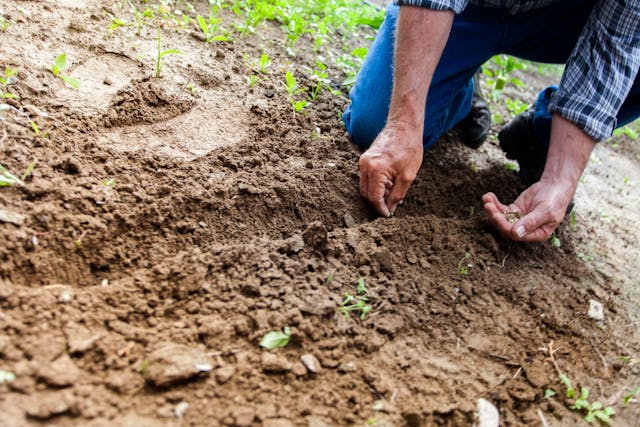
When does a seed start growing? The vast majority of seeds start growing when they are exposed to enough water, which activates hormones inside them. Some seeds need sunlight or other things, but water is by far the biggest trigger.
Seeds can be a very efficient way for a plant to spread its DNA over a fairly large area. However, not all plants produce seeds. Plants like ferns and mosses produce spores, which blow in the wind. Some plants also reproduce by growing a new plant from a rhizome or a tuber. The rhizome is like a stalk that grows underground and when it gets far enough away from the original plant, a new plant sprouts up.
A seed has three parts. Those are the embryo, the endosperm, and the seed coat. The embryo is a miniature plant that has a root, a stem, and one or two small leaves. The embryo is what is going to grow into a new plant. The endosperm is the nutrient and the food source that the embryo will use to grow. It is usually made up of starch, oil, sugar, and protein. Then there is the seed coat, which has to be strong enough to protect the embryo, sometimes for a very long time.
There are two basic types of seeds. The first type are called naked seeds because they are not inside a fruit. Conifer trees produce naked seeds, and you can see them whenever you pick up a pinecone. The name for these seeds is gymnosperms. The seeds on a conifer are in the pinecone, but when it opens they break off and are dispersed by the wind. They can also float, so they can be carried away on water. The second type of seeds are the ones that form in a fruit. These are probably what we think of when we think of a seed. The seed develops inside the ovaries of the plant and then the ovary becomes the fleshy fruit that covers the seed. The idea here is that animals eat the fruit and then excrete the seeds later on after they have passed intact through the animal’s digestive system. Interestingly, we usually eat the fruit and throw away the seeds, but with nuts we eat the seed and throw away the fruit. Peanuts, beans, and peas are all seeds, as are coffee beans and cacao beans. These kind of seeds are called angiosperms.
So, when does a seed start growing? The thing that activates the majority of seeds is water. Plants need water, carbon dioxide, nutrients, the right temperature, and sunlight to grow. Most seeds don’t need sunlight because the embryo is not going to be photosynthesizing. There are a few seeds that are triggered by sunlight and they lie dormant until a tree falls down in the forest and makes a space for the sunlight to come through, but the majority don’t need sunlight. They don’t need carbon dioxide as an embryo for the same reason. They need nutrients, but the energy requirement for the young embryo, at least until it has grown enough to take in its own nutrients, is packed in the seed with it. They need oxygen as well. They have to make energy from their store of nutrients, and they do that by burning them in the presence of oxygen, in the same way our bodies make energy from the sugars we get from food. They also need the right temperature, which varies depending on the plant. So, the only things that the seed needs is water, oxygen, and the right temperature. The coating of the seed is very strong and it can keep the contents safe for days, months, and sometimes years. Scientists have actually managed to germinate 2,000 year old date seeds, so there doesn’t seem to be a limit to how long a dormant seed can last. If a seed doesn’t have water, oxygen, and the right temperature, it will stay in its dormant form.
So, what triggers a seed to start germination. Seeds are kept dormant by a hormone called abscisic acid (ABA). The signal to start germinating is given by a hormone called gibberellin (GA). When ABA is the dominant hormone the seed stays dormant and when GA is the dominant hormone, it starts to grow. All seeds are different because different plants grow in different environments, but the amounts of ABA and GA hormone can be altered by the presence of water, or heat. While the seed is dry, ABA is dominant, but once the seed becomes damp, the seed starts to produce GA and when that reaches the right amount, it triggers the seed to start burning nutrients for energy and to grow. Likewise, the same happens with temperature. When it is cold, ABA is dominant, but when the temperature warms up, GA is produced and the seed starts to germinate. Some seeds can even switch off germination if the warm period is just a short anomaly. There are other seeds that need to be opened by fire first, such as the giant redwood, before moisture can get in. And there are other seeds that can read the color of the light at sunrise, which changes as spring arrives. All of these seeds have evolved to start germinating when the conditions are optimal. And this is what I learned today.
Photo by Binyamin Mellish: https://www.pexels.com/photo/man-planting-plant-169523/
Sources
https://www.nytimes.com/2008/06/17/science/17obseed.html
https://www.science.org.au/curious/earth-environment/plant-germination
https://www.dnr.state.mn.us/forestry/education/seeds/whatisaseed.html
https://en.wikipedia.org/wiki/Rhizome
https://cosmosmagazine.com/nature/seed-germination-thermometer
https://www.smithsonianmag.com/smart-news/seeds-use-tiny-brains-decide-when-germinate-180963625
https://www.conifers.org/topics/seed-dispersal.phphttps://www.sciencelearn.org.nz/resources/104-plant-reproduction-without-seeds
